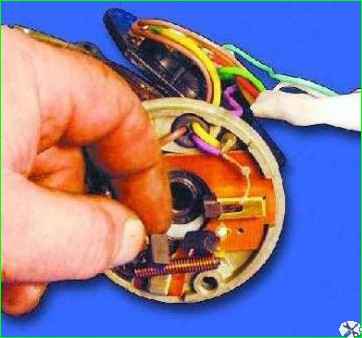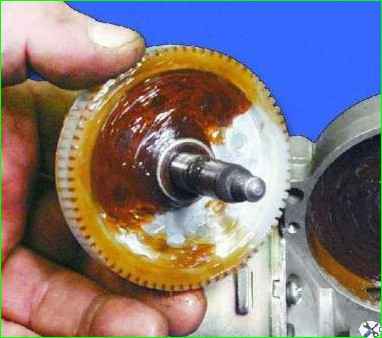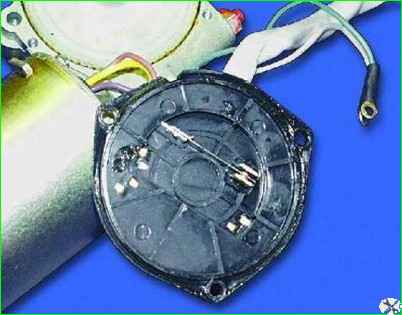To disassemble the gear motor, unscrew the screws securing the gearbox cover 6 and remove it together with the limit switch panel 4
Then unscrew the screws securing the gearbox housing 11 to the electric motor housing 8 and disconnect them.
Remove armature 9 of the electric motor.

To remove gear 3 of the gearbox, unscrew the crank securing nut, remove the retaining ring from the axle and remove the axle with gear and washers from the housing.
After disassembly, blow out the internal cavities of the electric motor with compressed air to remove carbon dust deposits and check the condition of the brushes and commutator.
The brushes must move freely in the brush holders without jamming, and the springs must be intact and have sufficient elasticity.
Clean the collector with fine-grained sandpaper, and then wipe with a clean rag lightly greased with petroleum jelly.
If the collector is severely burnt or worn out, it is better to replace the gear motor with a new one.
Check for signs of jamming on the armature shaft journals.
If necessary, clean them with fine-grained sandpaper.
When assembling, move the brushes away from the commutator so as not to break them or damage their edges, and insert the armature into the body with extreme caution, avoiding hitting the armature on the poles so as not to break them.
After assembly, to align the bearings, tap the gear motor housing with a wooden hammer, and then check it on the stand.
When installing the crank, position it so that in its final position it is parallel to the short wiper rod and directed towards the electric motor.

If the brush springs are damaged or have lost their elasticity, replace them

Check that the brushes move easily in the brush holder.
They should move freely, without jamming.
Replace worn or chipped brushes.
When replacing, solder the leads of the new brushes to the brush holder.

Clean the collector with fine sandpaper if it is dirty or has marks, scratches, etc.
If the commutator is badly worn or burnt, replace the armature or gearbox with electric motor assembly.
If you find traces of jamming on the armature journals, clean the journals with fine sandpaper.

Replace the gearbox with severely worn or broken teeth.

Clean burnt or oxidized contacts of the self-stop mechanism with fine sandpaper.
Data for checking the gear motor
Rotation speed of the gearmotor shaft at a supply voltage of 14 V, a load torque of 1.47 Nm (0.15 kgf m) and an ambient temperature of 25±10 °C, min -1 :
- - first (small) 30–40
- - second (large) 55–70
Current consumption at the above load torque, A, no more than:
- - at first speed 3.5
- - at second speed 5





